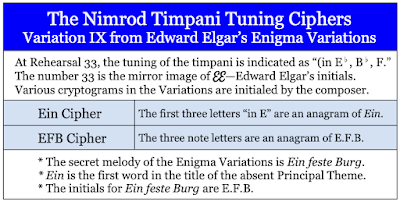 |
| The Tower of London. |
You are not only responsible for what you say, but also for what you do not say.
A thorough investigation of the Enigma Variations by Edward Elgar uncovered a cornucopia of cryptograms, and it is highly probable there are even more awaiting to be detected and decrypted. These secret codes are incredibly important because they encode the answers to Elgar’s sphinxian riddles. What is the secret melody behind the Enigma Theme? What is the secret “dark saying” hidden ensconced within the Enigma Theme? Who is the secret friend portrayed in Variation XIII? The covert principal Theme is Ein feste Burg (A Mighty Fortress), the famous Reformation hymn by Martin Luther. No one would ever guess a Roman Catholic composer like Elgar would surreptitiously quote the battle hymn of the Reformation, a piece composed by a heretic excommunicated by the Pope. The Enigma Theme’s “dark saying” is an incredibly ingenious Music Box Cipher. The secret friend portrayed in Variation XIII is Jesus Christ, the Lord of Elgar’s Roman Catholic faith. A discreet subset of these ciphers identifies the Turin Shroud, the most studied religious artifact in history that is believed to be the burial cloth of Christ.
 |
| The Nimrod Timpani Cipher |
There are at least seventeen ciphers that encode the letters EFB, the initials for the covert Theme (Ein feste Burg). The first is the Enigma Theme Keys Cipher. The second is the Enigma Theme Tempo Marking Cipher. The third is the Enigma Theme Timpani Tuning Cipher. The fourth is the Enigma Theme Clefs Cipher. The fifth is the Enigma Theme Relative Modes Cipher. The sixth is the Nimrod Timpani Cipher in which the tuning for the three timpani drums for Variation IX is indicated as E-flat, B-flat, and F.
The seventh is the “FAE” Cipher in Variation XIII. The eighth is the Letter Cluster Cipher in the titles for Variations XII and XIV. The ninth is the Enigma Date Cipher at the end of the original score. The tenth is the Dominant-Tonic-Dominant (5-1-5) Cipher embedded in the Mendelssohn fragments of Variation XIII. The eleventh is the Cover Page Cipher where Elgar traced a box and wrote the letters “FEb” not once, but twice, on the original cover page of the Enigma Variations.
The twelfth is the Enigma Date Cipher appearing on the final page of the original Finale where Elgar wrote “FEb” for a third time. The thirteenth is the Enigma Variations Key Numbers Cipher. The fourteenth is the Mendelssohn Melodic Intervals Cipher. The fifteenth is the Clarinet Mendelssohn Solo Nominal Notes Cipher. The sixteenth is the Clarinet Key Signature Transposition Cipher in Variation XIII. The seventeenth is the Extended Finale Acrostic Anagram Cipher. With so many ciphers encoding the identical set of initials, it would be ridiculous to insist they could collectively be the product of coincidence or contrivance.
 |
| Cover Page to the Enigma Variations (Autograph Score) |
%20Original%20Ending.png) |
| Original ending to the Enigma Variations (Autograph Score) |
The interrelated decryptions of the Enigma Variations Ciphers are mutually consistent and reinforcing, erecting an elaborate yet rational set of solutions to one of musicology’s enduring mysteries. With so many ciphers pinpointing the same answers, there is no room for doubt. The ciphers are genuine, and on that basis, we may be confident that the answers they encode are true and accurate. These solutions to Elgar’s enigmas are highly unpalatable to secular scholars like Julian Rushton who reflexively attribute them to coincidence, confirmation bias, and even contrivance. Ultimately the only thing that is contrived is Rushton’s vacuous and flawed objections. Like the Bible they routinely disparage, academics contend the Enigma ciphers and their decryptions must all be concocted in some elaborate ruse to misinform and mislead rather than to enlighten and guide. If the ciphers are merely the product of an overactive or determined imagination, how then does one account for their precise and consistent solutions? The secret melody to the Enigma Variations is Ein feste Burg by Martin Luther. The secret friend of Variation XIII is Jesus Christ, Elgar’s inspiration behind not only the Enigma Variations but also his sacred oratorios (The Light of Life, The Dream of Gerontius, The Apostles, and The Kingdom) and Violin Concerto in B minor. To learn more about the secrets of the Enigma Variations, read my free eBook Elgar’s Enigmas Exposed. Please help support and expand my original research by becoming a sponsor on Patreon.
 |
| Elgar's Enigma Variations Title Anagram Ciphers |


No comments:
Post a Comment